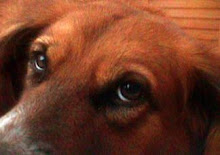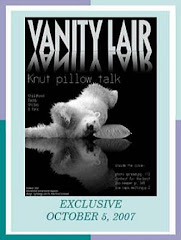 Wer da so ausgetreckt posiert, ist nicht ganz klar...
Wer da so ausgetreckt posiert, ist nicht ganz klar...No way of knowing exactly who it is, stretched out on the rock....-
 Das gleiche gilt für diesen Bär, der letzten Monat so faul herumlag, als gerade ein Freund aus unserem Aussenposten Rodrigues den Zoo in Johannesburg besuchte...-
Das gleiche gilt für diesen Bär, der letzten Monat so faul herumlag, als gerade ein Freund aus unserem Aussenposten Rodrigues den Zoo in Johannesburg besuchte...-The same goes for this bear who just lay around lazily while a friend of Knut's outpost Rodrigues visited the zoo in Johannesburg...
 Doch eins ist sicher, diese beiden sind Afrikas einzige beiden Eisbären...-
Doch eins ist sicher, diese beiden sind Afrikas einzige beiden Eisbären...-Though , one thing is sure, these are the only two polar bears still living in captivity in Africa.
 Es können also nur Geebee oder Wang sein... Eisbärin Geebee kam 1986 wie ihr männlicher Counterpart Wang im Alter von 6 (!) Monaten nach Johannesburg. Geebee, ein Wildfang aus Kanada, und Wang aus Sapporo (Mutter Shiro und Vater Pole) wurden damals gegen Löwen eingetauscht...-
Es können also nur Geebee oder Wang sein... Eisbärin Geebee kam 1986 wie ihr männlicher Counterpart Wang im Alter von 6 (!) Monaten nach Johannesburg. Geebee, ein Wildfang aus Kanada, und Wang aus Sapporo (Mutter Shiro und Vater Pole) wurden damals gegen Löwen eingetauscht...-So, it's either Geebee or Wang...Female Geebee came as her male counterpart 1986 at age 6 (!) months to Johannesburg. Geebee from Canada's wild and Wang from Sapporo in Japan (mother Shiro and father Pole) were swapped for lions.
 So, what is different for polar bears in Africa?
So, what is different for polar bears in Africa?"The only polar bears in Africa have so adapted to the climate that they don't go into their cold rooms anymore. (...)
Their lack of interest in the cold room in their enclosure is not the only difference from polar bears in the wild. Geebee and Wang have also lost the hair under the pads of their feet, which in the wild is necessary to protect them against ice and snow.
A change of diet may have something to do with it. They are fed chicken and rabbit, as opposed to the seal meat that they would normally eat under Arctic conditions, says Dominic Moss, a nature conservationist and keeper at the Johannesburg Zoo.
He says, "Seals have a layer of blubber that helps the bears to build up a thick layer of fat to insulate them against the extreme cold of the Arctic."
Geebee is the female and Wang is male. However, "we do not expect our bears to breed because it doesn't get cold enough to stimulate their breeding cycle. They breed in their winters, which can get as cold as -40 degrees," he says.
When the bears first arrived, according to Moss, they used the refrigerator room that was especially built for them, but after a couple of years they adapted to the heat, and they just never used the room again.
However, when snow was poured into their enclosure during a children's snow week-end a couple of months ago, the bears looked home-sick, revelling in it.
These animals are known for their swimming skills, and the Zoo has made efforts to make them feel at home by building a swimming pond for them. (...) ."
(Find full article here/18.09.2002)
"Johannesburg Zoo is almost as old as the city of Johannesburg itself. The city was founded in the late 1880s and the zoo opened its gates for the first time in 1904. (...) The enclosures within the zoo are home to more than 3,000 species of animal, including polar bears, which are an unusual sight in the middle of Africa. They are provided with an excellent environment with a large pool, and seem to be quite happy even in the absence of snow and ice. The zoo also houses some of the species you would expect to see on this continent – such as the plentiful lions and tigers."
It would have been interesting to get to know more about the history how polar bears had come to South Africa in the first place...
From article (1), Mr. Fatehmamode from Rodrigues(2,3,4), Jeanette Verster, found on Internet (5,6)
Related article with another photo from 2005 here














































4 Kommentare:
Very interesting post.
The fact that polar bears can adapt so quickly to a totally new climate gives me hope for their survival. As the polar ice caps continue to melt, polar bears are experiencing such huge changes. So many of them don't make it, which is very sad. But if enough of them can learn to adjust to a warmer situation and change their diet, then perhaps the whole species won't go extinct. I would hate to see that happen...
I just got the confirmation that Wang & Geebee are doing fine, both bears are excited, keeping their claws crossed for the African teams. As only polar bears in Africa they represent not only South Africa, but the other African teams too...
WakaWaka....
Well I must admit this story has left me quite depressed. I know that everyone means well and does their best for all concerned. No offense meant at all. I've just been chewing on this since last night when I read this. I had hoped there were no polar bears in African zoos, but alas....The truth is, I do not like zoos. I have never liked them. I prefer to see the animals in their natural habitat. I realize it triggers my own deep feeling of imprisonment, limitation and a sense of not living up to my full potential. So, yes, any sadness must be handled from within first. Still, I look forward to the day when humanity no longer needs to keep such majestic creatures on display.
BH,
Betsy
p.s. please don't let my opinion inhibit your reporting Birgit, your blog is an important archive for the WWBC and many others!
Dear Betsy,
Thank you a lot for your comment, to be honest , I expected more comments like yours here.
I can very well understand your feelings, me too, I was hoping very much not to find any polar bears in Africa.
There had been also polar bears in Egypt, which is another story.
The problem is that when you dig deeper, you will find a lot more depressing stories in a lot of countries. I have decided to use the FIFA World Cup to look at least into the polar bear history of the zoos of the participating nations which very often is not easy at all. Most of the times you will not even get an opportunity to write to the zoos and it is nearly impossible to find out more about their stories and backgrounds (which is what I would like to do... just not to forget them).
As to Wang and Geebee: Someone from Rodrigues visited them last year in September and took some of these photos which in fact made me look up more about them. The person who was there said that the enclosure was OK, that he had the impression that they were fine although most of the times sleeping. As to the climate, South Africa is not always hot, warm summers yes, but when it is winter, as now, temperatures can go down to 6°. There are other countries keeping polar bears where the climate is worse.
They do some enrichment at Jo'burg with their animals as I have learned some days ago with someone in charge of the carnivores there.( Btw, I was really happy to see that I got an answer from the zoo, so often I am less lucky!)
You are right that polar bears belong into the wild, there is no doubt about it, but out there are a lot of bears still in zoos, purchased in times when people did not yet question keeping them behind bars.
Bear history is quite depressing and it really goes for all countries!!
Some countries have learned and changed the ways of keeping them, some have decided not to keep them anymore,critical are the zoos which have nothing learned at all and keep bears just for the fun of the people without giving a thought how the bears feel and what the bears need.
So, more stories are coming, as to Wang and Geebee I hope very much that the time they will have, will be an enriched one.Born probably by end of 1985 they are not the youngest anymore. So, all the best to them!
Birgit
And I would love to know more about the 24 years they have already spent at Jo'burg, if anybody reading this here, knowing more about them, having pics and stories, you are welcome to contact me...
simba.aussenposten@gmail.com
Kommentar veröffentlichen